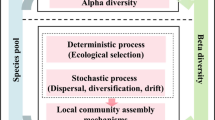Summary
Soil cores collected under a birch tree (Betula pubescens) on an experimental plot showed a progressive change in types of sheathing mycorrhiza with distance from the tree base. Seedlings grown in cores in a glasshouse also developed different mycorrhizal types depending on distance from the tree at which the cores were taken, but the types on seedlings were often different from those in the parent cores. When cores were taken directly beneath fruitbodies and sown to birch in a glasshouse, seedlings developed mycorrhizas of Laccaria, Inocybe and Hebeloma in cores from beneath these fruitbodies, but they seldom developed Lactarius mycorrhizas and never developed Leccinum mycorrhizas in cores taken beneath these fruitbodies. Similarly, when seedlings were grown in soils supplemented with vermiculite-peat inocula in a glasshouse, Laccaria and Hebeloma readily formed mycorrhizas, butLactarius pubescens seldom did so and Leccinum andAmanita muscaria never dit so. Yet all these fungi form mycorrhizas on birch seedlings in aseptic conditions.
The results suggest a distinction between ‘early stage’ and ‘late stage’ mycorrhizal fungi of birch. Early stage fungi readily infect seedlings from resident or introduced inoculum in normal, unsterile soil, whereas late stage fungi do not readily form mycorrhizas in these conditions.
Similar content being viewed by others
References
Fleming L V 1983 Succession of mycorrhizal fungi on birch: infection of seedlings planted around mature trees. Plant and Soil 71, 263–267.
Ford E D, Mason P A and Pelham J 1980 Spatial patterns of sporophore distribution around a young birch tree in three successive years. Trans. Br. mycol. Soc. 75, 287–296.
Fox F M 1983 Role of basidiospores as inocula of mycorrhizal fungi of birch. Plant and Soil 71, 269–273.
Harper J E and Webster J 1964 An experimental analysis of the coprophilous fungus succession. Trans. Br. Mycol. Soc. 47, 511–530.
Last F T, Mason P A, Wilson J, Deacon J W and Walker C 1983 Succession: Its relevance when selecting sheathing mycorrhizal fungi for inoculating young trees. Nature London (in press).
Mason P A, Dighton J, Last F T and Wilson J 1983 Procedure for establishing sheathing mycorrhizas in tree seedlings. For. Ecol. Manage. 5, 47–53.
Mason P A, Last F T, Pelham J and Ingleby K 1982 Ecology of some fungi associated with an ageing stand of birch (Betula pendula andB. pubescens). For. Ecol. Manage. 4, 19–39.
Author information
Authors and Affiliations
Rights and permissions
About this article
Cite this article
Deacon, J.W., Donaldson, S.J. & Last, F.T. Sequences and interactions of mycorrhizal fungi on birch. Plant Soil 71, 257–262 (1983). https://doi.org/10.1007/BF02182660
Issue Date:
DOI: https://doi.org/10.1007/BF02182660




